| The
Dump was about the size of our modern 5 cent piece and was
re-struck after being cut from the dollar. A crown surrounded
by the words 'New South Wales' and the date '1813' appear on
one side with the words 'Fifteen pence' across the centre of
the other side. The dump
is slightly larger than the hole from which it came due to the
spread of metal during re-striking. |
In the beginning . . .
The settlement of Australia by
Europeans began with the departure of the First Fleet from England in
1787. The English Government provided none of the normal
implements of commerce and trade, such as coins and banknotes. This
was a time of severe currency shortage in the United Kingdom, with
tradesmen's tokens, countermarked coins, bank tokens and other money
of necessity circulating freely. No
coinage was available to England's colonies.
Officials of the new colony would be paid in produce from the company
store and even free citizens would have
little need of money.
When Captain Arthur Phillip,
Governor of the new settlement, arrived in Sydney Cove in 1788 with
eleven ships and 1,487 people, including 759 convicts, the small
colony was virtually penniless. Apart from 300 pounds in currency held
by the Governor, the only coins available were those carried in the
pockets and purses of the passengers. It was not foreseen that the
small colony would almost starve to death because of drought, poor
soil and various other problems which made it impossible for the
settlement to become self-sufficient.
The first fleet brought sufficient
provisions, with careful rationing, to keep its passengers alive for
only two years. Their survival relied on the ability of the convicts
to work the land and harvest crops. However, no-one had made
allowances for the lack of farming experience, the unfamiliar soils or
the harsh climate they found.
The first year's crop failed and
most of the next year's harvest was required to replenish seed stocks.
Draft animals and proper farming equipment were not available - it was
more than 15 years before a
plough was used in the colony.
For the first five years the colony lived on the edge of starvation.
The prolonged drought forced Phillip to spend some of his hoard of
pounds to obtain supplies from Cape Town.
In 1792 the rain finally came and a
successful harvest enabled the colony to become self sufficient in
food production. In an ironic twist, it was only after this that
trading ships from distant lands began to arrive, bringing with them
the colony's first 'consumer goods' - clothing, boots, butter, tea and
rum. The colonists now required some form of currency to pay the
traders for the goods delivered. Attempts to induce the ships'
captains to accept promissory notes (which could only be redeemed on
the next visit to England), failed as they wanted cash to buy fresh
cargos on the way.
The colonial authorities back in
England had no inclination to send coinage to the settlement, knowing
full well that it would be immediately spent on trade goods and
disappear out of the colony within weeks of its arrival.
Australia had a balance of payments problem from the very start.
Cut Dollars.
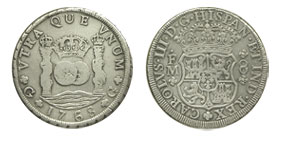
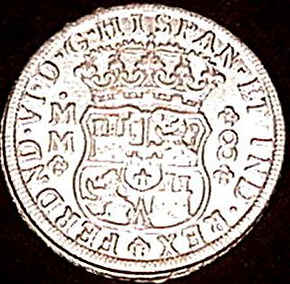 |
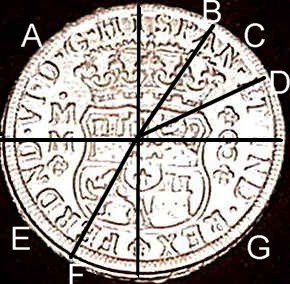 |
| The
Australian way of cutting the dollar was different from the
American 'pieces of eight'. A & G equalled 1 shilling and
six pence. (15 cents). B C D & F were valued at six pence
each (5 cents), E was worth 1 shilling (10 cents). |
- The practice of cutting Spanish
dollars into smaller segments to provide a fractional currency was
a well accepted practice in many countries by the time the colony
was established at Sydney Cove. The practice led to the famous
term 'pieces of eight',
where the original coin was quartered, and then each quarter
segment was halved, leaving eight, approximately equal, pieces.
- The American term 'two
bits', is derived from two
of these pieces being equal to quarter of a dollar or 25 cents.
Holey
Dollar see photos above
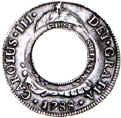 
The strategy of mutilating each coin,
which had been used in various other countries at that time,
effectively caused traders to spurn it. Macquarie's master stroke in
creating the Holey Dollar had created two coins out of one. Not a
mutilation but 2 whole coins. The outer ring which he called the Colonial
dollar had a new value of five
shillings (in those days called a dollar). The inner portion, called
the Dump,
was valued at fifteen pence (1 shilling and 3 pence).
Macquarie's initiative dramatically
increased the number of coins in circulation and distinguished them as
local currency, therefore deterring their removal from the colony on
departing trading ships. Not only did the coins solve the immediate
currency problem, but Macquarie also made a substantial profit in the
process. He had paid four shillings and nine pence for each silver
dollar, but the new face values totalled six shillings and three
pence.
British penny, 1797
(Cartwheel penny)
This
is an example of the 1797 British penny, which became the
first official Australian coin after a shipment arrived in
Sydney in 1800. The coins in this shipment were given a local
value of two pence by a proclamation of the Governor. The
coins remained in use for some 60 years and found their way to
Melbourne in the 1830s and 1840s. Examples found in
archaeological excavations can be seen in the Melbourne
exhibition. The coins were made in Birmingham by Matthew
Boulton on presses driven by James Watt's new steam engine. It
was the first use of the new engine. |
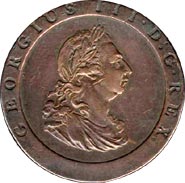 |
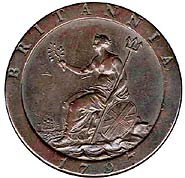 |
| Obverse
– Bust of King George
III laureate facing right. Around, incuse on a broad rim:
GEORGIUS III D:G: REX (George the third, by the grace of God,
King). |
Reverse
– The back of the coin
depicts a seated figure, Britannia. Impressed into a raised
rim is the legend BRITANNIA 1797. |
| Called
Cartwheel pennies
they were big, ugly and heavy, and Australia's first official
coins. The 'Cartwheel' pennies were not received
enthusiastically. Historically, however, they are magnificent.
They were the first
coins officially exported to the colonies
and included the first copper pennies ever struck in England.
They were also the first
English coins to be struck using steam power.
|
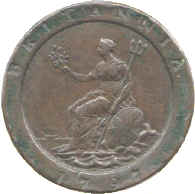 |
The coins were dated
1797 and 1799 and all bore a rather unflattering portrait of George
III on one side and Britannia on the reverse.
Members of the New
South Wales Corps had the ability to raise capital by borrowing
against their regimental pay, which
was accumulating back home in England.
It was this facility which enabled the elite of the Corps to snatch
control of trade in the colony and establish rum as the most common
currency.
This happened in 1793
after the arrival of the American trading ship, the 'Hope', with 7,500
gallons of rum in her cargo. The
other goods she carried were desperately needed but the Hope's
incorrigible captain insisted that he would sell nothing to the
colonists unless they first bought all of his rum. The New South Wales
Corps officers saw this as an opportunity rather than a rort and
formed a syndicate, with regimental paymaster John Macarthur at it's
head, pulling the necessary financial strings.
They bought the cargo
and distributed it at a huge profit. The vast pool of rum flooded into
the market place at grossly inflated prices and at once became a means
of exchange. For their efforts, the New South Wales Corps were
immediately dubbed the 'Rum
Corps', a name which stuck until
their recall to England in 1810.
A well documented case
connected with the rum trade was the construction of Sydney's (and
Australia's) first hospital - more commonly known as the Rum Hospital.
Built on the orders of Governor Macquarie between 1810 and 1816, the
contract was let out to three entrepreneurs, D'Arcy Wentworth,
Alexander Riley and Garnham Blaxcell in
exchange for the rights to import 60,000 gallons of rum.
They used
part of this rum to pay the wages of the hospital construction
workers, and made a fortune in
doing it. The consortium paid 10 shillings a gallon for the rum and
then inflated the value to £2 17s 6d. Ironically, forty years later a
part of this building would be converted to house the Sydney Mint for
the production of official gold sovereigns and half sovereigns.
Colonial Banknotes
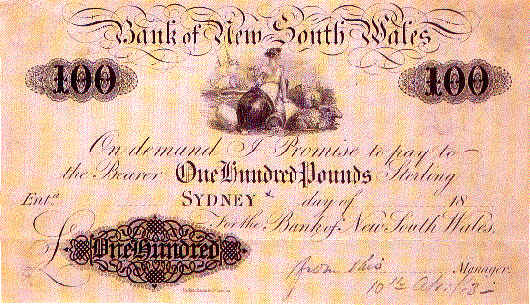
Coverage of Australia's
early currency would be incomplete without a reference to the
banknotes issued by private banks. The Bank of New South Wales,
Australia's first public company, was founded in 1817. The scheme to
create the bank was undertaken by Governor Lachlan Macquarie and a
group of wealthy colonial businessmen.
The formation of the
new bank reflected the confidence of the private businessmen in the
future of the colony. It was to be the first of many such public
investments. By 1850, the colony had a fully fledged currency system
with over thirty banks providing the cornerstone for a rapidly
increasing volume of commerce.
The issue of private
banknotes from 1817 was one of the most important financial feats in
Australia's history, paving the way for the economic growth and
prosperity which followed. During the course of the next 90 years, a
wide variety of banknotes were issued. Many banks did not survive the
'boom and bust' nature of the times while others, through mergers,
name changes and takeovers, exist in the three major banking groups of
today - ANZ, NAB and Westpac.
Many banks, with wealth
invested from overseas, made the largest contribution to the fledgling
economy, providing a large proportion of the capital needed for the
pastoral expansion which occurred from the 1830's onwards.
|